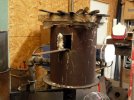My Fogg style forges are built with a piece of round pipe - 12" minimum, 16" max - about 16" long. You also need a 3" slice of the same pipe for the top, and a round plate 1/2" wider than the pipe.
Here is how I make them with 16" OD pipe:
Cut the front/rear forging ports, drill the burner port and weld the burner sleeve over it, and weld on the outer shelves.
Line it with 2" of wool.
Coat that with 3/4" of refractory ( simplest to build up in 1/4" layers every hour). Because the pipe is open on both ends, it is easy to put in the refractory.Set it aside.
The top is the 3" piece of the same pipe as the shell, with a steel disc welded to one end. Simplest way is to use a disc 1/2" wider than the ring and weld all the way around from the outside. Holes are drilled every 2-3 inches all around it 1/2" in from the open edge. Three short "clips" (0,120,240) are welded on to align the top with the shell when placed on it. If you are going to use a TC, put a piece of 1/2" stainless pipe through the center of the top so it will stick out about 1/2" past the refractory.
Put sheet metal screws in the holes around the rim to make spikes that stick inside about an inch to an inch and a half. These will hold the refractory in place. Place 2" of wool in the lid, then pour in the castable refractory until level with the edge. Let cure for a week.
Make up an 18" round mold for the base from a length of thin 3" high banding ( or a slice of 18" pipe), set it on a piece of plywood, and cast a round slab for the bottom in Cast-o-lite or Mizzou. Make the top smooth and level. Leave the band on the slab. Let it cure for a week or so.
The shell sits on the base, and 2" inches of kitty litter are poured in.
Set the top on the forge body.
Put in the burner and fire on as low as it will run for 15 minutes, raise the flame to medium for 15 minutes, raise to high for 15 minutes. Let cool overnight. Check for cracks and patch as needed.
Coat all exposed refractory with ITC-100 and refire for 15 minutes.
This makes a very robust forge that will do damascus and any general forging needed. Repairs are easy, and it can be disassembled if needed. The refractory lining will take a little longer to heat up, but will hold the heat very evenly once soaked for 15 minutes. The outside will be far cooler than you would imagine. THe kitty litter will catch flux drips, and can easily be replaced.
You can use the same technique to build a tiny 8"X10"table-top vertical forge, or one made from a 55 gallon drum. I honestly don't know why more small vertical forges aren't built by beginners, as they are easier to make .... probably because we old guys keep telling them how to build the standard type forges

Karl B. Andersen has. Mine does not get hugged that often.



